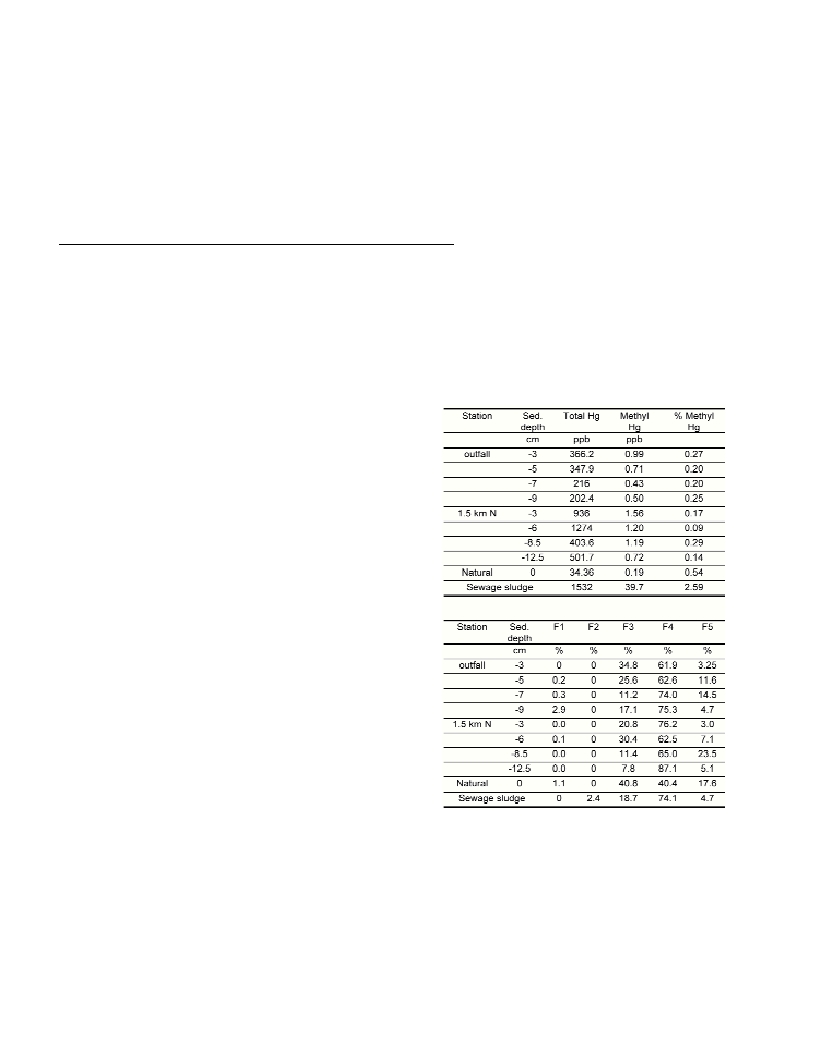Rapp. Comm. int. Mer Médit., 37,2004
243
MERCURY SPECIATION IN SEDIMENTS FROM A SEWAGE-SLUDGE MARINE DISPOSAL SITE
Efrat Shoam-Frider
1
, Gedalia Shelef
2
and Nurit Kress
1*
1
Israel Oceanographic & Limnological Res., The National Institute of Oceanography, PO. Box 8030, Tel Shikmona, Haifa, Israel 31080
- efrat@ocean.org.il - * nurit@ocean.org.il
2
Division of Environmental Engineering and Water Resources, Faculty of Civil Engineering, Technion - Israel Institute of Technology,
Technion City, Haifa 32000 Israel - Shelef@tx.technion.ac.il
Abstract
Mercury speciation in marine sediments collected at a sewage sludge disposal site showed it to be associated mainly with the organic
matter fraction (amorphous organic sulfur compounds and humic acid), reducing it’s availability to the marine environment. The third most
prominent fraction was cinnabar. Methylmercury, the most deleterious species to human health consisted only of 0.1-0.5 % of the total
mercury in the sediment sample, compared to 2.6% of the total mercury in the sewage sludge.
Keywords : mercury, speciation, sediment, sewage sludge, marine environment
Background
Mercury is a naturally occurring element that enters the
environment as a result of natural (e.g., volcanoes, fires, surface
emissions) and anthropogenic sources (e.g., combustion, commercial
products). The biogeochemical cycle of mercury is complex and it can
be found, among others, as elemental mercury vapor, gas-phase and
dissolved ionic mercury, particulate bound, in organic forms and as
cinnabar. Mercury is bioaccumulative and toxic impacting the
environment and man(1). Of all the mercury species, methylmercury
is the one that poses the higher risk to human health.
Although most of the introduction of mercury is via the
atmospheric pathway, land based sources can cause local problems or
“hot spots”. Along the Israeli Mediterranean coast there are two areas
with increased mercury in the sediments: in the northern coast,
opposite a chlor alkali plant and in the southern coast, at the marine
disposal site of excess (16,000 m
3
day
-1
) sewage sludge from the Dan
Region Wastewater treatment plant(2). The outfall operates since
1987 and is located 5 km offshore, at a water depth of ca. 38 m. About
60 Kg mercury year
-1
enters the marine environment with the sewage
sludge(3). To date, only total mercury concentrations were measured
in the area’s sediments. This study aimed to determine the mercury
speciation in the sediments of the outfall area to assess the possibility
of mercury accumulation in the food web.
Experimental
Sediments were sampled in October 2002. The methods of
sediment sampling, preservation and preparation are thoroughly
described elsewhere(1). Speciation was performed using selective
extractions of biogeochemically relevant fractions(4). Brie?y, five
fractions were determined: F1(water soluble), F2 (‘human stomach
acid’soluble), F3 (organic, humic acid chelated), F4 (elemental
mercury and amorphous organic sulfur compounds), F5 (mercury
sulfide, cinnabar). Methylmercury was determined in a separate
aliquot of the sediment. Sediments cores of three stations were
analyzed: one station at the outfall, one station located 1.5 km
northward of the outfall and a non affected station located 5.5 km
northwards of the outfall. Fresh sewage sludge was sampled from the
treatment plant, dried and analyzed in the same manner as the
sediment samples. QA/QC of the results was performed with certified
international standards.
Results and discussion
Total mercury, methyl mercury and mercury speciation in the
sediment samples and in fresh sewage sludge results are presented in
Table 1. Total mercury concentration was the lowest at the natural
station. At the affected stations, total mercury concentrations
decreased with increased depth of the sediment. The highest total
mercury concentration was found at the sewage sludge sample.
Methyl mercury in the sewage sludge was 2.6% of the total mercury
while in the sediment samples the percentage of methylmercury was
much lower, in the range of 0.1-0.5%. Most of the mercury was found
in the F4 fraction followed by the F3 fraction, ie, the mercury was
associated with the organic matter fraction: amorphous organic sulfur
compounds (F4) and humic acid (F3). The presence of elemental
mercury in the F4 fraction was ruled out by pyrolisis analysis. The
third most prominent fraction was F5, cinnabar. There was almost no
mercury associated with the F1 and F2 fractions, the most accessible
and bioavailable, neither in the sludge nor in the sediments. The
distribution of mercury among the different fractions in the two
stations affected by the sewage sludge was similar to that in the
original sludge. The mercury species distribution in the natural station
was slightly different with and higher relative contribution of the F3
fraction compared to the F4 fraction. This may be due to the
association of mercury with natural humic acids. These results
indicate that the mercury introduced to the marine environment with
the sewage sludge is mainly associated with the most stable
complexes of mercury, reducing it’s availability in the environment.
Table 1. Total mercury, methyl mercury and speciation of mercury (in %
from total mercury) in activated sewage sludge and in marine sediments
at the disposal site.
References
[1]-U.S. Environmental Protection Agency (EPA), 2000. Mercury
research strategy. Office of Research and Development. EPA/600/R-
00/073.
[2]-Kress, N, Herut, B. and B.S. Galil, 2003. Sewage sludge impact on
sediment quality and benthic assemblages off the Mediterranean coast of
Israel – a long-term study. Marine Environmental Research, 57(3): 213-
233.
[3]-UNEP/WHO (1999). Identification of Priority Hot Spots and
Sensitive Areas in the Mediterranean. MAP Technical Reports Series No.
124. UNEP, Athens. 102 p.
[4]-Bloom, Nicolas S.; Preus, Eve; Katon, Jodie; Hiltner, Misti, 2003.
Selective extractions to assess the biogeochemically relevant fractionation
of inorganic mercury in sediments and soils. Analytica Chimica Acta,
479(2): 233-248.

